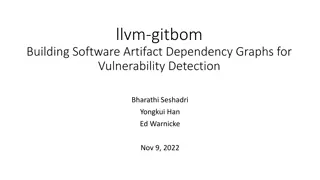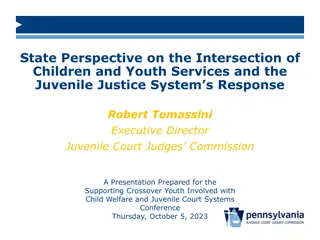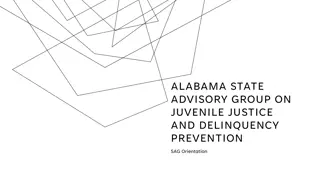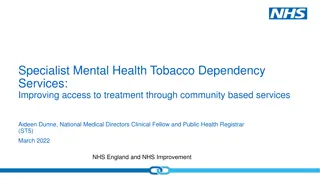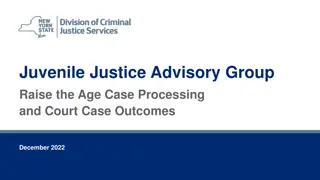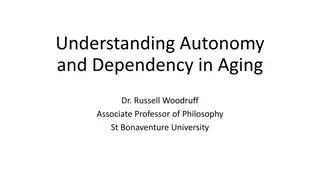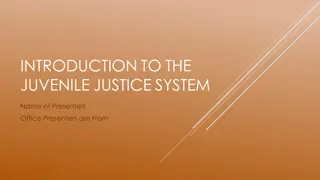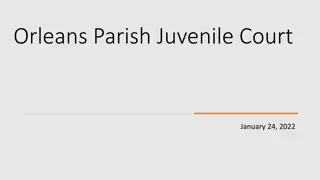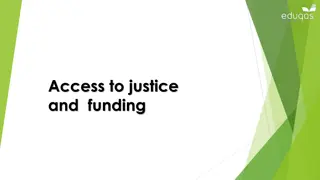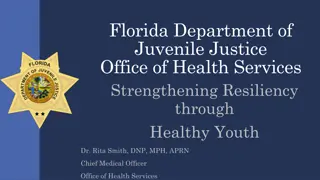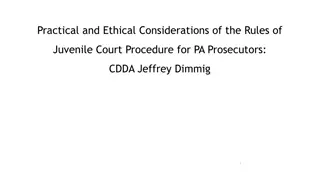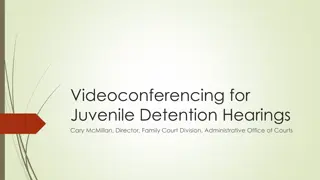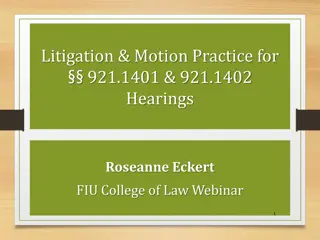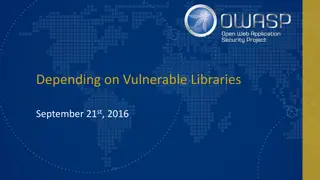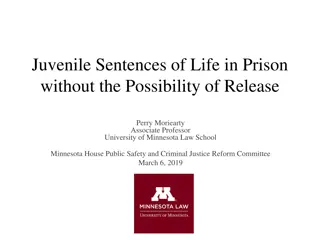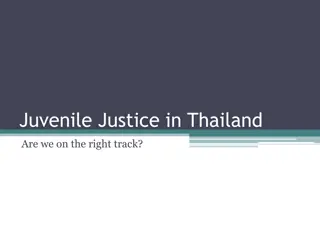Legal Decision Making in Juvenile Dependency Cases
This content highlights the critical legal decision-making process in juvenile dependency cases, including reporting and assessment of child abuse, screening, assessment, and protective custody filing. It delves into the procedures followed by authorities to ensure the safety and well-being of children in vulnerable situations.
Uploaded on Mar 02, 2025 | 0 Views
Download Presentation

Please find below an Image/Link to download the presentation.
The content on the website is provided AS IS for your information and personal use only. It may not be sold, licensed, or shared on other websites without obtaining consent from the author. Download presentation by click this link. If you encounter any issues during the download, it is possible that the publisher has removed the file from their server.
E N D
Presentation Transcript
Critical Legal Decision Making in Juvenile Dependency Cases Appellate Court Seminar February 7, 2019, Salem, Oregon Inge Wells, Senior Assistant Attorney General Oregon Department of Justice Amy Miller, Legal Director CASA for Children, Inc.
Child Abuse Reporting and Assessment 2 3/2/2025 Appellate Court Seminar
Reporting of Child Abuse 3 ORS 419B.005 ORS 419B.055; OAR Chapter 413, Division 15. A report of child abuse may be made to DHS or law enforcement. ORS 419B.015. Upon receipt of a report, DHS or law enforcement shall immediately cause an investigation to be made to determine the nature and cause of the abuse of the child. ORS 419B.020(1). 3/2/2025 Appellate Court Seminar
Screening 4 Reports received by DHS are screened to determine the appropriate response. OAR 413-015-0100. Reports are referred for child protective services (CPS) assessment or closed at screening. Response time between receipt of report and initial contact is within 24 hours or within five calendar days. OAR 413-015-0210. 3/2/2025 Appellate Court Seminar
Assessment 5 As part of its assessment, DHS determines whether there is a present danger safety threat or an impending danger safety threat. OAR 413-015-0425. If a safety threat is identified, a safety plan must be put in place. OAR 413-015-0432. Safety plans may be in-home or out-of-home; an in-home plan requires one cooperative parent. Initial safety plans remain in place until the assessment is complete. OAR 413-015-0437. Present danger safety threats require a protective action plan, which must be put in place before a CPS worker leaves the home and which cannot continue longer than 10 calendar days. OAR 413-015-0435. Ongoing safety plans are developed after an assessment is completed, and are used to control the impending danger safety threats as they are uniquely occurring within a particular family. OAR 413-015-0450. 3/2/2025 Appellate Court Seminar
Protective Custody/Filing Dependency Petition 6 3/2/2025 Appellate Court Seminar
Protective Custody 7 A CPS worker may take a child into protective custody without a court order when there is severe harm or threat of severe harm to a child in the present. OAR 413-015-0455. Severe harm means (a) significant or acute injury to an alleged victim s physical, sexual, psychological, cognitive or behavioral development or functioning, (b) immobilizing impairment ; or (c) life threatening damage. OAR 413-0105(61). 3/2/2025 Appellate Court Seminar
Statutory Authority For Protective Custody 8 A child may be taken into protective custody without a court order when the child s condition or surroundings reasonably appear to be such as to jeopardize the child s welfare. ORS 419B.150(1)(a). LC 821: Proposed legislation may amend ORS 419B.150 to authorize protective custody without a court order when there is reasonable cause to believe that there is an imminent threat of severe harm to the child. 3/2/2025 Appellate Court Seminar
Shelter Hearing 9 If a child is taken into protective custody, a shelter hearing must be held the following day. OAR 413-015-0455; ORS 419B.185. Parent, child or ward shall be given an opportunity to present evidence to the court that the child can be returned home without further danger of suffering physical injury or emotional harm, endangering or harming others, or not remaining within reach of the court process prior to adjudication. ORS 419B.185(1). Court shall determine whether the department made reasonable (active) efforts to prevent removal and whether removal is in the child s best interests. ORS 419B.185(1). 3/2/2025 Appellate Court Seminar
Considerations for parent/child attorneys 10 Placement Can the child be returned to parent(s)with a safety plan? DHS shall make diligent efforts to place with relatives or persons with caregiver relationships and to place siblings together. ORS 419B.192. Visitation DHS must develop a temporary visitation plan either when the child enters substitute care or at the time of the shelter hearing. OAR 413-070- 0860(1)(e). Engagement in services Complete cooperation with all services and signed releases of information can be persuasive in a borderline case [to return the child home]. (Oregon State Bar, Juvenile Law (2017)). Shelter review (2nd shelter) Provides more time gather & present evidence to support placement with parent(s). See ORS 419B.875(2)(e). 3/2/2025 Appellate Court Seminar
Filing a Dependency Petition 11 Any person may file a dependency petition. ORS 419B.809(1). DHS files a petition when a child is taken into protective custody or juvenile court intervention is necessary to assure the child and family receive appropriate services. OAR 413-015-0455(2). DHS consults with AAG or DDA to ensure petition is legally sufficient. ORS 419B.100(1). Address and resolve parentage issues. Prior to adjudication, the court may dismiss the petition provided that every party has had an opportunity to investigate and present a case supporting the petition or waived the opportunity to do so. ORS 419B.809(7). 3/2/2025 Appellate Court Seminar
Adjudication of dependency petition 12 Absent good cause, a petition must be adjudicated within 60 days. ORS 419B.305(1). Written good cause finding is required to continue beyond 60-day period. ORS 419B.305. 42% of juvenile court petitions are adjudicated within 60 days. (Juvenile Court Improvement Program, 2017 year-end statistical reports). 3/2/2025 Appellate Court Seminar
Considerations for parent/child attorneys 13 Discovery Disclosure must be made as soon as practicable after the filing of a petition, and no later than 30 days after the filing of a petition alleging jurisdiction. ORS 419B.881(2). Investigation An independent investigation of the case requires the lawyer to (1) interview the client, potential witnesses, and others who can help provide an understanding of why the petition alleging the juvenile court s jurisdiction was filed; (2) explore the accuracy of the petition; and (3) aid in determining what factors will resolve the difficulties. Consider independent expert evaluations. Attend all out-of-court case-planning meetings. Negotiation & Adjudication Given the low standard of proof (preponderance), the position of all parties may be enhanced by a negotiated solution. Trial rate of 9% (Juvenile Court Improvement Program, 2017 year-end statistical reports) Settlement conference not statutorily required; practice varies statewide. Often the parties can negotiate a settlement by agreeing to admit to part of the petition in exchange for the petitioner dismissing the remainder of the petition. 3/2/2025 Appellate Court Seminar
Considerations for parent/child attorneys 14 Disposition The juvenile court may order a parent to engage in a service only if the service bears a rational relationship to the jurisdictional findings of the court. State ex rel Juv. Dept. v. G.L, 345 Or 158 (2008). Appeal The trial lawyer should immediately discuss the possibility of appeal when a court s ruling is contrary to the client s position or interests. Regardless of whether the lawyer believes an appeal is appropriate or if there are any viable issues for appeal, the lawyer should advise the client at the conclusion of each hearing that the client has a right to appeal from any adverse order or judgment resulting from a jurisdictional hearing, review hearing, permanency hearing, or termination-of-parental-rights trial. Sources: Oregon State Bar, Juvenile Law (2017); Oregon State Bar, Specific Standards for Representation in Juvenile Dependency Cases (2017). 3/2/2025 Appellate Court Seminar
Considerations for agency attorneys 15 Allegations admitted or proved must reflect the reasons why the child s welfare is endangered. Reunification services must be rationally related to the bases for jurisdiction. At a permanency hearing, the department s efforts and a parent s progress are evaluated by reference to the facts that formed the bases for juvenile court jurisdiction. Dept. of Human Services v. N.T., 247 Or App 706 (2012). Wardship can be terminated if the bases for jurisdiction are ameliorated. 3/2/2025 Appellate Court Seminar
Permanency Planning 16 3/2/2025 Appellate Court Seminar
Adoption and Safe Families Act 17 Adoption and Safe Families Act, 42 USC 671, 675 (1997) (ASFA) ASFA imposes reasonable efforts requirements and timelines on states to reduce the amount of time children spend in foster care. Enforced against states through Spending Clause; failure to make required findings results in loss of Title IV-E funding. ASFA was incorporated into Oregon s juvenile code in 1999. 3/2/2025 Appellate Court Seminar
Obligation to seek legal permanency 18 DHS must make reasonable efforts to preserve and reunify families by (1) establishing conditions for return and (2) implementing a permanency plan to make it possible for a child to safely return home. OAR 413-070-0510. DHS must also develop a concurrent permanent plan of adoption, guardianship, placement with a fit and willing relative, or APPLA. 3/2/2025 Appellate Court Seminar
Developing a Permanency Plan 19 A permanency plan and concurrent plan must be developed within 60 days of a child s placement in substitute care. Concurrent permanent plans are identified in preferential order, with adoption being the most preferred plan. OAR 413-070-0512(1)(d)(E). 3/2/2025 Appellate Court Seminar
Changing a Permanency Plan 20 AAG and DHS legal assistance specialist must approve the decision to change the permanency plan to adoption. OAR 413-070-0512(1)(h). Other changes in permanency plan away from reunification are made by a permanency committee. OAR 413-070-0514(1). At a permanency hearing, the juvenile court determines the permanency plan for a child. ORS 419B.476(5). This determination must be child-centered, based on a current evaluation of the child s circumstances. Dept. of Human Services v. S. S. , 283 Or App 136 (2016). 3/2/2025 Appellate Court Seminar
Considerations for agency attorneys 21 Has DHS made reasonable efforts with regard to both parents? Are there unresolved parentage questions? If a parent has made progress, what is the likelihood that the progress is sustainable given the parent s history? Is a child adoptable? Is there a person willing to be a guardian? 3/2/2025 Appellate Court Seminar
Filing a Petition to Terminate Parental Rights 22 No petition to terminate parental rights may be filed until the court has determined that the permanency plan should be adoption. ORS 419B.476(3). If a child has been in substitute care for 15 of the most recent 22 months, ASFA requires that DHS file a petition to terminate parental rights unless one of the circumstances in ORS 419B.498(2) applies. 3/2/2025 Appellate Court Seminar
Considerations for parent/child attorneys 23 ASFA Timelines DHS shall file a petition to terminate parental rights if a child has been in substitute care for 15 months of the most recent 22 months unless one of the circumstances described in ORS 419B.498(2) applies. ORS 419B.498. Reasonable (active) efforts Individualized & considered within the framework of jurisdictional bases, Parents must have a reasonable opportunity to adjust their conduct, Evaluated over the life of the case with focus on sufficient pre-permanency hearing period. Dept. of Human Services v J.E.R., 293 Or App 387 (2018). Ward s health & safety are paramount concerns. ORS 419B.476(2). Sufficient progress If the court determines that further efforts will make it possible for the child to safely return home within a reasonable time, the court may order that the parents participate in specific services for a specific period of time and make specific progress [in those services] within that period of time. ORS 419B.476(4)(c). 3/2/2025 Appellate Court Seminar
Considerations for parent/child attorneys 24 Motions to dismiss jurisdiction Any party may move to dismiss jurisdiction at any point during the dependency case, including after the plan has been changed away from reunification with a parent or guardian. Dept. of Human Services v. T.L., 279 Or App 673 (2016). As long as the permanency plan for a child is reunification, the proponent of continued dependency jurisdiction bears the burden to prove that ongoing jurisdiction and wardship over the child is warranted. Dept. of Human Services v. A.R.S., 258 Or App 624 (2013). Individualized permanency plan determination Reunification is the preferred permanency plan. When reunification cannot be achieved, the court must determine the proper permanency plan for a child based on the child s conditions and circumstances. Oregon State Bar, Juvenile Law (2017). Compelling reasons If the court finds sufficient evidence to change the plan to adoption, the opponent of the change in plan has the burden to show the escape clause of ORS 419B.498(2) applies--that there is a compelling reason for DHS not to proceed with termination of parental rights. Dept. of Human Services v S.J.M, 364 Or 37 (2018). 3/2/2025 Appellate Court Seminar
Practical challenges for parent/child attorneys 25 Marginalized litigants Intergenerational trauma Racial and ethnic disparities Inadequate resources and long-standing deficits can make compliance with ASFA timelines impossible Fluidity of client positions Constraints of the public defense system 3/2/2025 Appellate Court Seminar
Practical challenges for agency attorneys 26 Caseworker turnover Lack of service providers/foster placements Assessing when parents have made lasting change Prioritizing child safety 3/2/2025 Appellate Court Seminar
What happens while a case is on appeal? 27 3/2/2025 Appellate Court Seminar
Appeals: by the numbers 28 petitions filed (trial court) 2017 cases filed (COA) 2017 type of resoution (cases resolved 2017) case type mean days to closure AWOP written opinion per curium dismissed other 130 35 52 13 Dependency TPR 5281 1541 229 39 18 4 44 9 3 0 235 290 Source: Juvenile Court Improvement Program, 2017 year-end statistical reports. 3/2/2025 Appellate Court Seminar
Juvenile Court Retains Jurisdiction 29 Notwithstanding the filing of an appeal, the juvenile court is not precluded, after notice and hearing from entering such further orders relating to the ward or youth offender s custody pending final disposition of the appeal as it finds necessary by reason only of matters transpiring subsequent to the order or judgment appealed from. ORS 419A.200(7)(a). 3/2/2025 Appellate Court Seminar
Required Hearings 30 When a child is in substitute care, the juvenile court is required to hold review and permanency hearings at certain intervals, regardless of a pending appeal. ORS 419B.449, ORS 419B.470. 3/2/2025 Appellate Court Seminar
Jurisdiction to terminate parental rights 31 Notwithstanding the filing of an appeal from a jurisdiction, disposition, review, or permanency judgment, the juvenile court may adjudicate a petition to terminate parental rights while the appeal is pending. ORS 419A.200(7)(b). 3/2/2025 Appellate Court Seminar
Advising the Agency 32 How does DHS decide when/how to proceed? Appeal from jurisdiction judgment: agency does not delay providing reunification services; time children spend in substitute care counts toward ASFA timelines. Appeal from permanency judgments changing plan to adoption or guardianship: assessing risks of proceeding while appeal is pending. DHS policy not to finalize adoption while appeal from TPR is pending. Tension between advancing legal arguments and minimizing delay. Putting case on hold pending an appeal. 3/2/2025 Appellate Court Seminar
Advising Parent/Child Clients 33 Trial & appellate counsel must collaborate to assess client s interests at both levels and advise client appropriately. Appeal from jurisdiction: client engagement is important given ASFA timelines Appeal from order for psychological evaluation: strongly consider whether to refrain from evaluation pending appeal Appeal from permanency hearing: discourage relinquishment/stipulation to TPR likely to delay trial due to possibility of TPR set aside 3/2/2025 Appellate Court Seminar
THE END: Thank you for your interest. 34 3/2/2025 Appellate Court Seminar
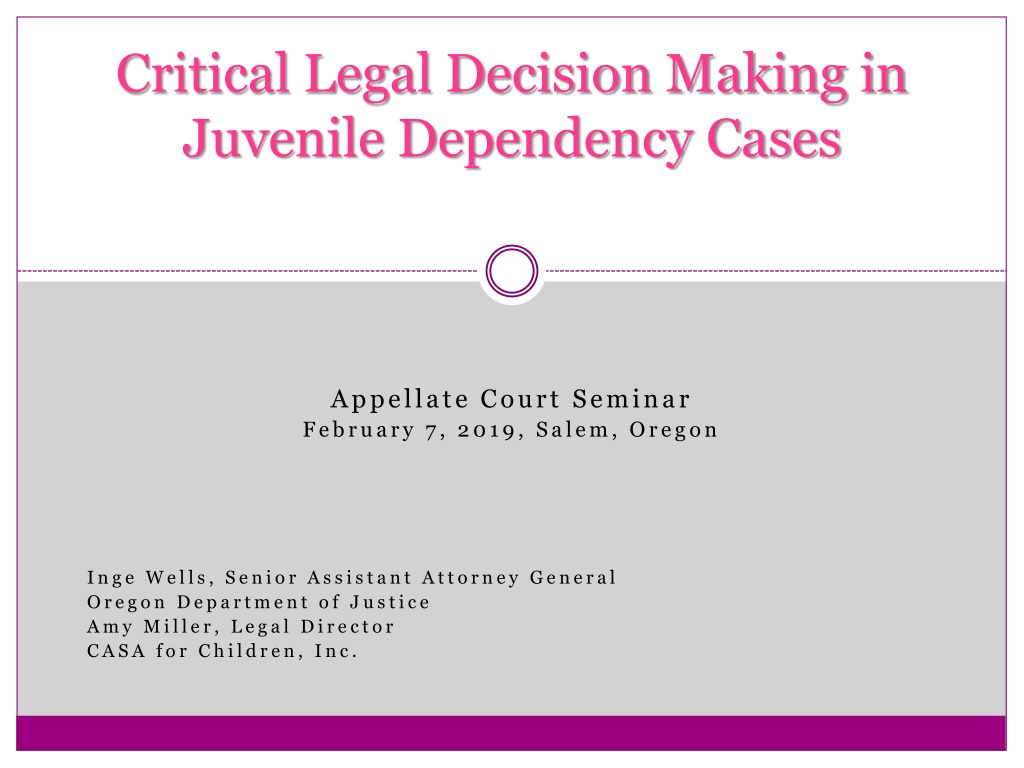
 undefined
undefined










